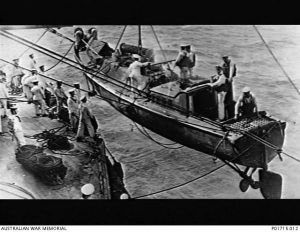- Author
- Letter Writer
- Subjects
- History - WW1, Letter to the Editor
- Tags
-
- RAN Ships
- HMAS Australia I
- Publication
- September 2015 edition of the Naval Historical Review (all rights reserved)
This letter was received from our ever helpful member Leyland Wilkinson who has recently moved from the Central Coast to Grafton.
As always the recent issue (June 2015) of the NHS Review’s front cover was a colourful introduction to the magazine, on this occasion showing troops being towed ashore at Gallipoli, by a picket boat from HMS London in 1915. London carried two picket boats, each 50 ft (15.24 m) long x 9 ft 6 in (2.89 m) beam, with a twin cylinder steam engine, powered by a coal fired boiler. These versatile craft were armed, when required, with a Hotchkiss 3-pdr gun mounted on the forecastle, two torpedos – one each side carried in dropping gear, a Maxim machine gun on top of the after cabin, plus a rack of rifles.
They were usually commanded by a midshipman, assisted by a senior sailor, two able seamen and a stoker who took great pride in their boats. The boats could be identified by brass rings around the top of the funnel. One ring indicated a boat stowed on the starboard side of the mother ship and two rings for a boat from the port side.
Boats could be made ready for duty whilst still stowed with a bucket of burning coals from the parent ship’s stokehold assisting in firing the boiler before the boat was hoisted out and made fast to the boom. Note the funnels were hinged and were laid down when the boats were inboard to prevent being fouled by the boat’s lifting strops.
The Navy List of 1914 shows 634 boats in service. HMAS Australia (I) carried two picket boats built by the Thames Ironworks, London in 1911. Existing plans show they were built for “The Colonial Cruiser Australia”.
An original picket boat, believed to have served with HMS Monarch at Jutland has survived the years, now known as Steam Pinnace No. 199. She is maintained by the National Museum of the Royal Navy and can be seen, in pristine condition during the summer months, regularly steaming around Portsmouth Harbour.
The attached photograph shows a picket boat being lowered from HMAS Australia with the funnel still folded in its storage position – AWM PO1715.012.

Best wishes – Leyland Wilkinson.
By Editor:Given his detailed knowledge Leyland has been asked if he might favour us with an article on Picket Boats.




